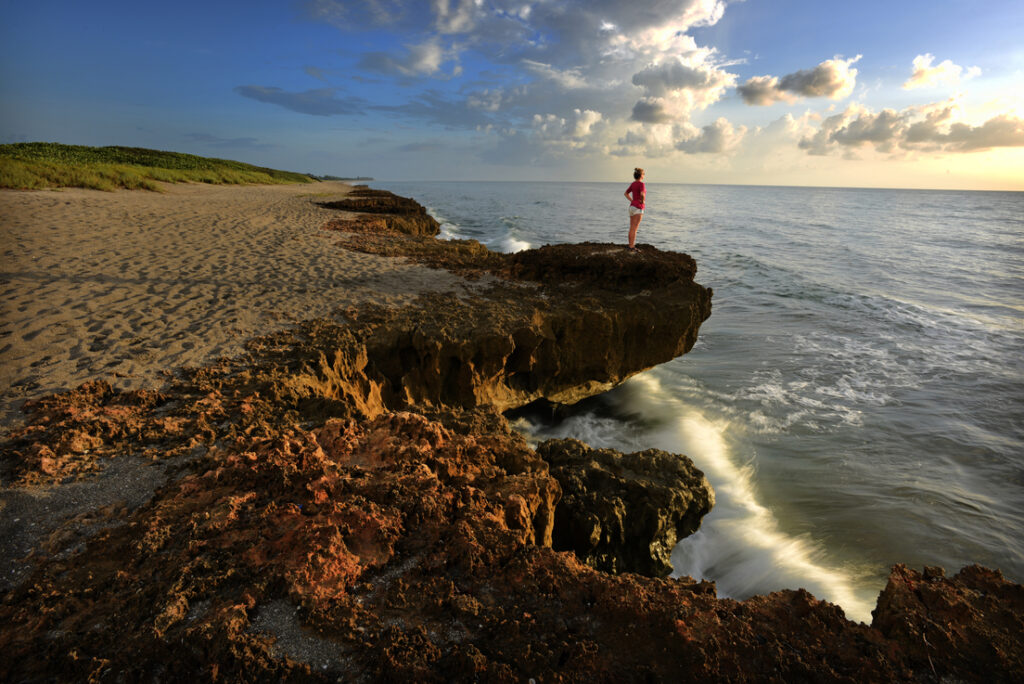By Kellilynn Hann

Blowing Rocks Preserve, just south of Jupiter on the Treasure Coast, is like no other place in Florida.
Of the Nature Conservancy’s 400 preserves in the United States, this is their most visited, drawing 55,000 people a year.
The main attraction is a mile-long limestone formation between the sand and sea. If you’ve arrived at high tide and the ocean is choppy, you’ll be treated to plumes of water shooting out of the rock, sometimes up to 50 feet in the air. If you arrive at low tide, you’ll be able to walk along the shoreline, searching all the nooks and crannies for shells, fossils, and that perfect Instagram photo.
The Science Behind the Spectacle
The rocks you see here are from the Anastasia Formation. It’s very common in Florida—most of Florida was built on limestone. What’s rare is that so much of it is exposed here.
Dr. Sarah Sheffield, Assistant Professor of Geosciences at the University of South Florida explained that the Anastasia Formation is made up of quartz sand and carbonate rock called coquina (which is just a word indicating limestone that’s composed of a bunch of shells mashed together), and it’s only found along the east coast of Florida.
“The rocks are being weathered down by a bunch of different processes. Chemical processes like weathering caused by rainwater and mechanical processes like wave action,” said Dr. Sheffield. This is what causes the explosive plumes of water you see.
Another surprising fact Dr. Sheffield shared: When you’re standing on the sand at Blowing Rocks, you’re actually standing on part of the Appalachian Mountains.
“The Appalachians are ancient,” she said, “and they used to extend much further down into what’s now Georgia. So that sand—which can be nearly 150 meters thick in parts of Florida—was transported down from Georgia as parts of the Appalachians weathered to nothing over millions of years.”
Dr. Sheffield said that because of all these forces, Blowing Rocks is changing slowly, every single day. “Just walking around and seeing how 2.5 million years have weathered these rocks out. … I think it’s absolutely beautiful to think about.”
An Ecological Treasure
The preserve straddles the barrier island with the Atlantic on one side and the Indian River Lagoon on the other. It’s also located where temperate and tropical zones intersect. This creates incredibly biodiverse habitats within a small area. As you walk the trails, you’ll see over 250 native plant species like subtropical hardwoods, three types of mangroves, gumbo limbo, wild coffee, Jamacia caper, and sea oats.
Another key role of the preserve is as a critical nesting site for four species of sea turtles: Loggerhead, Green, Leatherback, and Hawksbill. Each year, from March to October, more than 600 sea turtles avoid the light pollution of developed areas and use this dark stretch of beach to lay their eggs. They can lay an average of 100 eggs per clutch and visit multiple times per season. That’s thousands of sea turtles hatching here every year.
The craggy rocks can pose a challenge: Both adults and hatchlings can get wedged in the crevices. To solve that problem, The Nature Conservancy manages the Florida Sea Turtle Rescue Program. Every morning during the season, a group of staff and volunteers searches among the rocks to find trapped turtles get them back to the ocean.
 Escape To The Southeast Escape To The Southeast
Escape To The Southeast Escape To The Southeast

